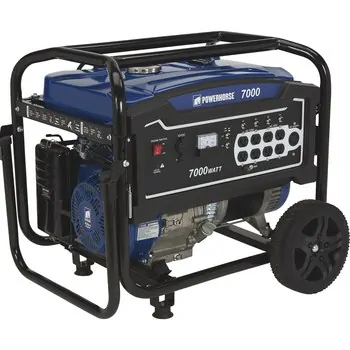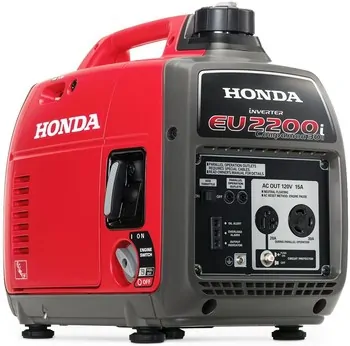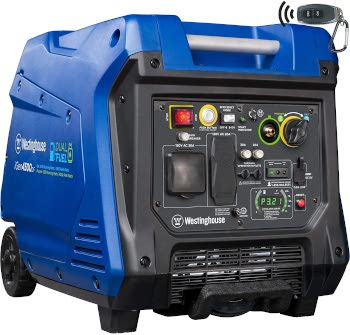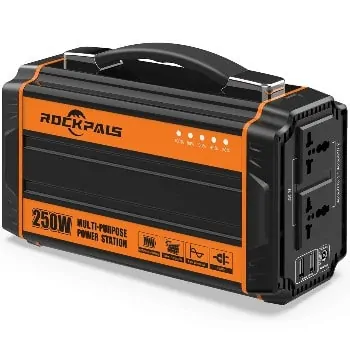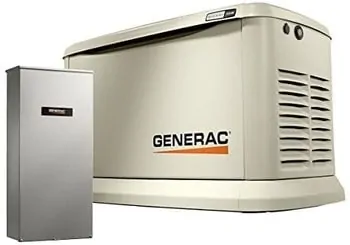Table of Contents
- 1 Types of Generators
- 2 Define the Generator’s Primary Purpose
- 3 Assess Your Power Needs
- 4 Explore Fuel Options and Their Implications
- 5 Outlets and Connectivity
- 6 Consider Noise Levels
- 7 Runtime and Fuel Efficiency
- 8 Starting Mechanism
- 9 Safety and Advanced Features to Look For
- 10 Budget Considerations
- 11 Brand Reputation
- 12 Maintenance and Longevity
- 13 Conclusion
Buying a portable generator is a significant decision that requires careful consideration.
Portable generators come in various shapes, sizes, and capacities, each designed for specific needs and scenarios. A wrong choice can not only be a waste of money but also leave you stranded when you most need a reliable power source.
For example, a generator suitable for camping may not be adequate for powering essential home appliances during an outage.
This portable generator buying guide is designed to simplify the process of selecting the best generator for your needs. We’ll cover everything you need to consider when buying a generator.
Types of Generators
Understanding the different types of generators is the first step in narrowing down your options. Here are the main categories you’ll encounter, along with their pros and cons:
Conventional Generators
These are the most common and widely available type of portable generators. They run on gasoline or diesel and are generally less expensive. However, they tend to be noisier and less fuel-efficient compared to other types.
Pros:
- Widely available and easy to find
- Generally less expensive
- Robust and durable for long-term use
Cons:
- Noisier operation
- Less fuel-efficient
- May not be suitable for sensitive electronics due to less stable power output
Inverter Generators
Inverter generators are the modern counterpart to conventional generators. They are quieter, more fuel-efficient, and produce cleaner power, making them ideal for sensitive electronic devices like laptops and smartphones.
Pros:
- Quieter operation
- More fuel-efficient
- Produces cleaner power suitable for sensitive electronics
Cons:
- Generally more expensive
- Lower power output compared to conventional generators
- May require more frequent maintenance
Dual-Fuel Generators
As the name suggests, dual-fuel generators can run on two types of fuel, usually gasoline and propane. This gives you the flexibility to switch between fuel types based on availability and cost.
Pros:
- Flexibility to switch between fuel types
- Can be more cost-effective in the long run
- Offers a backup fuel option for added reliability
Cons:
- May be more expensive upfront
- Slightly more complex to operate
- Bulkier than single-fuel options
Solar Generators
Solar generators are the eco-friendly option, harnessing the power of the sun to generate electricity. While they are silent and produce no emissions, their power output is generally lower, making them suitable for less demanding applications.
Pros:
- Eco-friendly with zero emissions
- Silent operation
- Low maintenance
Cons:
- Lower power output
- Dependent on weather conditions
- Initial setup can be expensive
Standby Generators
Though not exactly portable, standby generators are worth mentioning as they provide an automatic power supply in case of an outage. They are more expensive and require professional installation but offer the convenience of uninterrupted power.
Pros:
- Automatic power supply during outages
- Higher power output
- Long-lasting with proper maintenance
Cons:
- Expensive upfront cost
- Requires professional installation
- Not portable
Define the Generator’s Primary Purpose
Before you even start comparing brands or diving into technical jargon, it’s crucial to pinpoint the primary reason you’re in the market for a portable generator. The main use—be it as an emergency backup, for recreational activities, or work-related tasks—will serve as the compass guiding you through the myriad of options available.
Your generator’s primary use will directly influence the size and power output you’ll need. For instance, emergency home backup may require a generator capable of powering multiple essential appliances, thus necessitating a higher wattage. On the other hand, a generator for recreational use like camping may not need to be as powerful but should be more portable.
Also, emergency backup generators may benefit from advanced safety features and multiple outlets, while a generator for a job site might need to be more rugged and have specific types of outlets for industrial tools.
Here are our quick tips for some common scenarios:
-
Emergency Backup for Home: Requires a reliable, higher-wattage generator with safety features and multiple outlets.
-
Outdoor Activities: Portability and noise level are key. An inverter generator might be your best bet for powering sensitive electronics.
-
Job Sites: Durability and power output are crucial. Look for a generator designed to handle the wear and tear of a construction site.
-
Tailgating and Parties: A balance between portability and power is essential, along with features like multiple outlets for various appliances.
-
Boating and Fishing: Consider a generator that’s marine-rated or designed for the specific challenges of a wet environment.
-
Small Businesses: Reliability and fuel efficiency are key, especially if the generator will be running for extended periods.
Once you’ve defined your primary purpose, you’ll have a clearer idea of what to look for in a portable generator.
Assess Your Power Needs
Once you’ve defined the primary purpose of your portable generator, the next logical step is to assess how much power you need. This is a critical factor that will influence not only the type of generator you choose but also its size and cost. Here’s how to go about it:
Calculate the Wattage
Start by listing all the devices and appliances you plan to power. Each item will have a specific wattage requirement, usually indicated on its label or in its manual. Sum up these wattages to get an estimate of your total power needs. Remember to account for both running and starting wattages, as some appliances require extra power to start.
| Household Item | Starting Wattage (W) | Running Wattage (W) |
|---|---|---|
| Incandescent Light Bulb | N/A | 60 – 100 |
| Compact Fluorescent Light (CFL) | N/A | 14 – 23 |
| LED Light Bulb | N/A | 9 – 15 |
| Refrigerator (top-freezer) | 800 – 1200 | 100 – 800 |
| Refrigerator (side-by-side) | 1200 – 1800 | 100 – 800 |
| Air Conditioner (5000 BTU) | 1250 – 1500 | 500 – 600 |
| Air Conditioner (10000 BTU) | 2200 – 2500 | 800 – 1200 |
| Microwave Oven | 1000 – 1500 | 800 – 1000 |
| Toaster Oven | 1200 – 1800 | 1200 – 1500 |
| Coffee Maker | 800 – 1200 | 800 – 1200 |
| Electric Kettle | 1200 – 1500 | 1200 – 1500 |
| Hair Dryer | 1200 – 1800 | 800 – 1800 |
| Washing Machine | 1000 – 1500 | 500 – 1000 |
| Dishwasher | 1200 – 1500 | 1200 – 1500 |
| Iron | 1000 – 1800 | 1000 – 1800 |
| Television (LCD/LED) | N/A | 30 – 150 |
| Television (Plasma) | N/A | 150 – 500 |
| Laptop | 50 – 100 | 20 – 100 |
| Sump Pump | 800 – 1200 | 800 – 1200 |
| Desktop Computer | 200 – 600 | 150 – 300 |
Consider Peak vs. Continuous Power
Generators often have two power ratings: peak (or surge) power and continuous (or rated) power. Peak power is the maximum wattage the generator can handle briefly, while continuous power is what it can sustain for longer periods. Make sure your calculated wattage falls within the generator’s continuous power rating.
Factor in Future Needs
It’s wise to consider any future power needs you may have. If you plan to add more devices or appliances, or if your power needs are likely to increase for any reason, opt for a generator with some extra capacity.
The Importance of Accurate Assessment
An accurate assessment of your power needs will help you avoid two common pitfalls:
- Under-sizing: Choosing a generator that can’t meet your power needs will lead to frequent overloads and may damage both the generator and your appliances.
- Over-sizing: Opting for a generator that’s too powerful can be inefficient and result in higher fuel consumption and maintenance costs.
Practical Examples
-
Emergency Backup: If you need to power essential home appliances like a refrigerator, lights, and a heating system, you might need a generator with at least 5000 watts.
-
Outdoor Activities: For camping or tailgating, a smaller, more portable generator with a rating of around 2000 watts may suffice.
-
Job Sites: Power needs can vary widely, but industrial tools often require higher wattages. A generator with at least 8000 watts may be necessary for heavy-duty work.
By carefully assessing the amount of power you need in relation to your primary purpose for the generator, you’ll be better positioned to buy the right portable generator for your needs.
Explore Fuel Options and Their Implications
The type of fuel your generator uses can have a significant impact on its efficiency, cost, and environmental footprint. Here’s a breakdown of the most common fuel types and their implications:
Gasoline
Gasoline is the most commonly used fuel for portable generators. It’s readily available and offers a decent balance between price and performance.
It’s ideal for short-term, intermittent use like outdoor activities or as a temporary backup during power outages.
Pros:
- Widely available and easy to store
- Generally less expensive upfront
- Suitable for most residential and recreational uses
Cons:
- Shorter shelf life compared to other fuels
- More emissions and less eco-friendly
- Fluctuating prices can affect long-term costs
Diesel
Diesel generators are known for their fuel efficiency and are often used in industrial settings. They are best suited for job sites and heavy-duty applications where high power output and fuel efficiency are required.
Pros:
- Higher energy density, leading to longer runtimes
- Generally more fuel-efficient
- Suitable for heavy-duty and industrial applications
Cons:
- More expensive upfront
- Bulkier and heavier, affecting portability
- Less suitable for low-load or intermittent use
Propane
Propane generators are praised for their cleaner emissions and longer fuel shelf life and are thus often chosen for emergency power backup.
Pros:
- Longer shelf life, making it good for emergency backup
- Cleaner emissions compared to gasoline and diesel
- Easier to store in large quantities
Cons:
- Lower energy density, resulting in shorter runtimes
- Can be more expensive over time
- Requires additional storage space for tanks
Natural Gas
Natural gas generators are typically used for standby systems and require a permanent gas line connection.
Pros:
- Abundant and relatively inexpensive
- Cleaner emissions
- Ideal for standby generators with a permanent setup
Cons:
- Not suitable for portable generators
- Requires a permanent gas line connection
- Lower energy density compared to diesel
Solar
Solar generators use solar panels to convert sunlight into electricity, offering an eco-friendly option. They are suitable for low-power needs and environments where noise and emissions are a concern.
Pros:
- Renewable and eco-friendly
- Silent operation
- Low maintenance costs
Cons:
- Limited power output
- Dependent on weather conditions
- High initial setup costs
Prioritize Portability and Storage Features
When it comes to choosing the right portable generator, the term “portable” can be somewhat relative. Factors like size, weight, and design play a pivotal role in determining just how portable a generator truly is. These elements are not just about convenience; they can also impact how well the generator fits into your specific use-case scenario. Here’s what you need to consider:
Size and Dimensions
The physical dimensions of a generator can make a world of difference in its usability. Smaller, more compact generators are easier to store and transport, making them ideal for recreational activities like camping or boating.
On the flip side, larger generators often come with higher power output and greater fuel capacity, which could be more suitable for job sites or as a robust home backup. However, keep in mind that a larger size might require special storage solutions and could be cumbersome to move.
Weight
Weight is another critical factor that directly impacts portability. Lighter generators are generally easier to move around, especially if you plan to use the generator in different locations. This makes them ideal for temporary setups like outdoor events or camping trips.
Heavier generators, while often more robust and capable of higher power output, can be challenging to transport. They may require additional lifting equipment or multiple people to move, making them less ideal for applications requiring frequent mobility.
Design Features for Portability
Many modern generators come equipped with features designed to enhance portability. For instance, built-in wheels and handles can make a world of difference when you need to move the generator from point A to point B.
Some units even offer compact designs with storage compartments for accessories, adding an extra layer of convenience.
However, it’s essential to note that these additional features can sometimes add to the overall cost of the unit.
Outlets and Connectivity
Choosing the right portable generator involves more than just looking at the power output and price. The types of outlets and connectivity options are equally important factors to consider.
Types of Outlets to Consider
-
NEMA 5-20R Outlets: These are common household outlets for 120V/20A, capable of providing up to 2400W. They usually come in duplexes and may feature GFCI protection.
-
NEMA L5-30R and L5-20R Outlets: These are twist-lock equipped 120V outlets rated for 20A and 30A, respectively. They are often found in docks and campsites and can provide up to 2400W and 3600W.
-
NEMA TT-30R Outlets: Specifically designed for RVs and trailers, these 120V/30A outlets can provide up to 3600W.
-
NEMA 14-50R, L14-30R, and L14-20R Outlets: These are 120/240V outlets rated for 50A, 30A, and 20A, respectively. You will find them in 30 amp and 50 amp generators. They are suitable for heavy-duty applications and can provide power ranging from 4800W to 12,000W.
-
NEMA SS2-50R Outlets: These are rare but powerful 120/240V, 50A outlets, often used to hook up boats to shore power.
-
12V DC Receptacles: These are used for small devices and electronics, including sensitive devices like phones or laptops.
-
USB Ports: These 5V ports are increasingly common and essential for charging smartphones, tablets, and other USB-powered devices.
Connectivity Options to Look For
- Parallel Connectivity – This feature allows you to connect two generators to increase power output. If you think you might need more power in the future but can’t afford a larger generator now, choose one with parallel capabilities.
- Remote Start – A remote start feature allows you to turn on the generator without having to physically be near it. This is particularly useful for generators that will be placed at a distance from your living or working space.
- Wi-Fi Connectivity – Advanced generators offer Wi-Fi for easy monitoring and control via a mobile app. If you like tech-savvy solutions and want to monitor your generator’s performance remotely, opt for one with Wi-Fi capabilities.
- Transfer Switch Compatibility – A transfer switch allows for safe and easy connection to your home’s electrical panel. If you plan to use the generator as a backup power source for your home, make sure it is transfer switch compatible.
Consider Noise Levels
The importance of a generator’s noise level varies depending on the setting in which it will be used.
The noise level is usually measured in decibels (dBA). The lower the dBA rating, the quieter the generator.
For residential or recreational use, look for generators with a dBA rating between 50-65 .
Industrial generators may have higher dB ratings, but they are generally used in environments where noise is less of a concern.
Recommendations for Low-Noise Portable Generators
If noise level is a significant concern, consider opting for an inverter generator. I would recommend checking Honda EU3000iS and WEN 56200i. Both of these generators operate at a noise level of about 50 dBA and are very reliable and fuel-efficient. The Honda EU3000iS, while offering exceptional quietness and reliability, comes at a premium price though. On the other hand, the WEN 56200i offers a more budget-friendly alternative. For more options check out our guide on the best quiet generators.
Runtime and Fuel Efficiency
When it comes to portable generators, the term “runtime” refers to how long a generator can operate on a single tank of fuel. Fuel efficiency, on the other hand, is a measure of how effectively the generator converts fuel into electrical power. Both are critical factors that can significantly impact your experience with a portable generator.
Imagine you’re in the middle of a power outage, and your generator runs out of fuel in just a couple of hours. Not only is this inconvenient, but it could also be dangerous if you’re relying on the generator to power essential appliances. A longer runtime ensures that you have a consistent and reliable power source for extended periods, reducing the frequency of refueling.
It’s essential to find a balance between runtime and fuel efficiency based on your specific needs. For example, if you need a generator primarily for short bursts of high-power activity, you might prioritize runtime over fuel efficiency. Conversely, if you plan to use the generator for extended periods, fuel efficiency may be more critical.
The size of the fuel tank and the electrical load you place on the generator will also affect both runtime and fuel efficiency. Running a generator at full capacity will consume fuel more quickly but may be necessary for powering larger appliances or tools. Always consider the generator’s fuel tank size and compare it with the estimated runtime to get a realistic expectation of how long the generator will operate without needing a refill.
If you are looking for generators with excellent runtime, consider the Westinghouse iGen4500DF or the Champion 200954 4250-Watt Generator as reliable options.
Starting Mechanism
The starting mechanism of a portable generator is often an overlooked feature, but it plays a crucial role in your overall experience. Generally, there are three main types of starting mechanisms: recoil start, electric start, and remote start. Each has its own set of advantages and disadvantages, and the best choice for you will depend on your specific needs and preferences.
Recoil Start – The recoil start, or manual pull-start, is the traditional way to start a generator. It’s usually found in smaller, more portable models and requires pulling a cord to initiate the engine. While it’s a straightforward and reliable method, it does require some physical effort, which may not be ideal for everyone.
Electric Start – An electric start mechanism allows you to start the generator with the simple push of a button, eliminating the need for any pulling. This feature is often found in larger, more powerful models and is especially convenient for those who may find the manual pull-start challenging. Electric starts can be battery-operated or require a key for added security.
Remote Start – Remote start takes convenience to the next level by allowing you to start your generator from a distance, often via a key fob or even a smartphone app. This feature is incredibly useful in situations where the generator is not easily accessible or for those who prefer the ease of starting the generator without physical interaction. Models like the Westinghouse iGen4500DF offer this advanced feature, adding an extra layer of convenience.
When choosing a starting mechanism, consider your physical capabilities and the situations in which you’ll be using the generator. If you’re looking for ease and convenience, an electric or remote start, like those found in the best remote start generators may be ideal. However, if you’re looking for a no-frills, reliable option and don’t mind exerting a bit of effort, a manual pull-start could be sufficient.
Safety and Advanced Features to Look For
When selecting a portable generator, safety and advanced features should be high on your list of considerations. While power output, fuel efficiency, and starting mechanisms are essential, the additional features can significantly enhance your experience and provide peace of mind. Here’s what features to consider when buying a generator:
- Overload Protection – Overload protection is a feature that automatically shuts down the generator if it’s operating beyond its capacity. This is crucial for preventing damage to the generator and the devices connected to it.
- Automatic Voltage Regulation (AVR) – AVR ensures that the generator provides a consistent voltage output, protecting your sensitive electronics from voltage fluctuations. This is especially important if you plan to power devices like laptops, smartphones, or medical equipment.
- Low-Oil Shutoff – A low-oil shutoff feature automatically turns off the generator when oil levels are dangerously low, preventing engine damage. This is a must-have feature for those who may not be diligent about regular maintenance checks.
- Carbon Monoxide Detection – Some modern generators come with built-in carbon monoxide detectors that shut off the unit if dangerous levels of the gas are detected. This is a vital safety feature, particularly for those who plan to use the generator in enclosed or semi-enclosed spaces.
- Parallel Capability – Parallel capability allows you to connect two generators to increase power output. This feature is particularly useful for those who may need more power than a single unit can provide but don’t want to invest in a larger, more expensive generator.
- Eco-Mode – Eco-mode adjusts the engine speed to match the load, improving fuel efficiency and reducing noise levels. This is an excellent feature for those looking to maximize fuel economy and minimize environmental impact.
- Electronic Fuel Injection (EFI) – EFI provides more precise control over the fuel-air mixture, improving fuel efficiency, reducing emissions, and often making the generator easier to start in cold conditions.
- Digital Displays and Monitoring – Some advanced models offer digital displays that provide real-time monitoring of various performance metrics, including fuel level, power output, and runtime. This feature adds a layer of convenience and allows for more precise management of your generator’s performance.
Budget Considerations
Portable generators come in a wide price range. Consider your budget constraints while accounting for the following factors:
- Your power needs (higher wattage generators are generally more expensive)
- Frequency of use (occasional use vs. frequent use)
- Features and technology (inverter generators, fuel efficiency, noise level)
While it’s tempting to go for the cheapest option available, it’s crucial to understand that you often get what you pay for.
The initial cost of a generator can be deceiving. A low upfront price may seem attractive, but if the generator lacks essential features like overload protection or low-oil shutoff, you could end up spending more on repairs and maintenance in the long run.
Fuel efficiency is another factor that can impact your budget over time. A fuel-efficient generator, like those with Eco-Mode or EFI, can save you money on fuel costs in the long run, making it a more budget-friendly option over time.
Advanced features like remote start, digital displays, and parallel capability can add to the cost of a generator. Consider whether these features are essential for your needs and if they offer value that justifies the additional expense.
Don’t overlook the cost of regular maintenance, including oil changes, air filter replacements, and potential repairs. Generators with features like low-oil shutoff and EFI generally require less frequent maintenance, which can save you money in the long term.
Balancing your financial constraints with your power needs and desired features will help you find the ideal generator that offers both reliability and affordability.
Tips for buying a generator on a budget
Being on a budget doesn’t mean you have to compromise on quality or essential features. Here are some tips on how to get the most value for your money:
Tip #1: Prioritize essential features
Focus on the must-have features that align with your primary use for the generator. For example, if you need a generator mainly for emergency backup, prioritize long runtime and reliable starting mechanisms over advanced features like digital displays.
Tip #2: Look for multi-use functionality
If you need a generator for various purposes—like camping, job site use, and emergency backup—consider a versatile model that can serve multiple needs.
Tip #3: Consider fuel efficiency
A more fuel-efficient generator can save you money in the long run, even if the initial cost is slightly higher. Look for models with Eco-Mode or EFI features, as these can reduce your ongoing fuel expenses.
Tip #4: Shop around and compare prices
Don’t settle for the first deal you find. Prices can vary significantly between retailers, and special promotions or discounts can make a more expensive model suddenly affordable.
Tip #5: Consider pre-owned or refurbished models
If a new generator is out of your budget range, consider looking for certified pre-owned or refurbished models. These units are often much cheaper and come with a limited warranty for peace of mind.
Tip #6: Financing options
Some retailers and manufacturers offer financing options that can make a higher-end generator more accessible. While this can add to the overall cost due to interest rates, it does provide a way to fit a quality generator into a tighter budget.
Brand Reputation
When choosing a portable generator, don’t overlook the importance of brand reputation.
A reputable brand often equates to quality, reliability, and strong customer service.
Start by checking customer reviews and industry awards; these can offer valuable insights into a brand’s credibility. Brands like Westinghouse, Honda, and Champion, for example, have garnered accolades that speak to their reliability.
Also, consider the warranty and customer support offered, as these are indicators of a brand’s confidence in its products.
Long-standing brands usually have a track record of quality, adding an extra layer of trust to your purchase.
Maintenance and Longevity
When you invest in a portable generator, you’re not just buying a machine; you’re securing a reliable power source for years to come. Therefore, it’s crucial to consider the maintenance requirements and potential longevity of the generator you choose.
Maintenance Requirements
Some generators demand frequent upkeep, including oil changes and filter replacements, which can add to long-term costs. Opt for models with features like low-oil shutoff and self-cleaning capabilities to minimize maintenance time and expense.
Longevity and Build Quality
The materials and build quality directly impact the generator’s lifespan. Look for models made with durable materials like stainless steel and high-quality plastics.
Spare Parts Availability
Ensure that spare parts are readily available for the model you choose. This not only makes maintenance easier but also extends the generator’s life by allowing for timely repairs.
Conclusion
Choosing the right portable generator is a multifaceted decision that involves various factors, from understanding your power needs to evaluating brand reputation and long-term costs.
While budget constraints may limit your options, they don’t have to limit the quality or reliability of your choice. By prioritizing essential features, considering long-term expenses, and opting for reputable brands, you can secure a reliable power source that serves you well for years to come.
